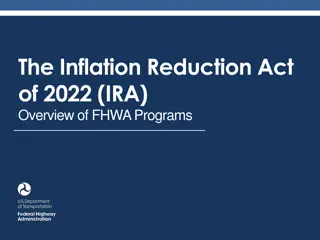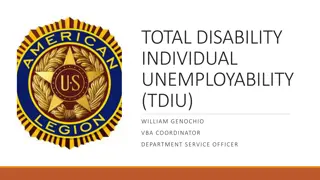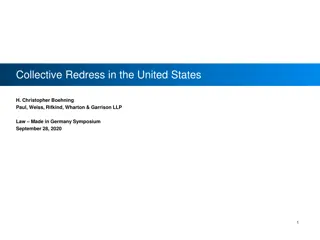
Understanding Total Disability Individual Unemployability (TDIU) Requirements
Learn about TDIU basics, degree of disability requirements, and ways to compute the single 60% or 40% disability for veterans to qualify for compensation. Explore scenarios and definitions related to substantially gainful employment and protective environments.
Download Presentation

Please find below an Image/Link to download the presentation.
The content on the website is provided AS IS for your information and personal use only. It may not be sold, licensed, or shared on other websites without obtaining consent from the author. If you encounter any issues during the download, it is possible that the publisher has removed the file from their server.
You are allowed to download the files provided on this website for personal or commercial use, subject to the condition that they are used lawfully. All files are the property of their respective owners.
The content on the website is provided AS IS for your information and personal use only. It may not be sold, licensed, or shared on other websites without obtaining consent from the author.
E N D
Presentation Transcript
1 Individual Unemployability Keith Garrison Associate Director, NCRBO Kgarrison@vfw.org
Objectives What is TDIU TDIU Requirements Ways to compute the Single 60% or 40% disability Unemployable Vs. Unemployed What is a Protective Environment What is Substantial Gainful Employment Scenarios 2 2
TDIU Basics Compensation will be paid as if the veteran was rated 100% disabled if it is shown that service-connected disabilities prevent the veteran from securing or maintaining substantially gainful employment. 38 CFR 4.16 3 3
Degree of Disability Requirements A single disability evaluated at 60% or more OR Two or more disabilities that equal a combined 70% and at least one 40% rating 4 4
Ways to compute the Single 60% or 40% disability If a veteran does not meet the single disability requirement, the following combinations of disabilities may be used: Disabilities of one or both upper extremities Disabilities of one or both lower extremities Disabilities from a common etiology/accident Disabilities from a single body system Multiple injuries incurred in action Multiple disabilities incurred as a POW 5 5
Ways to compute the Single 60% or 40% disability If a veteran has multiple service-connected injuries that affect their extremities (arms, legs) those disabilities may be combined to meet the single disability requirement The conditions may also be combined with any other disabilities resulting from the same incident or etiology 6 6
Ways to compute the Single 60% or 40% disability If the veteran has multiple disabilities that affect the same body system (respiratory, cardiovascular, etc...) or were caused by the same incident or event (car accident, combat action, etc ) these conditions may be combined to meet the requirement for a single condition. Disabilities incurred as a POW may also be combined to meet the single disability requirement 7 7
What the VA must find That the veteran is unable to work solely due to service-connected disabilities. It is not sufficient to state that the veteran is unemployable due to nonservice-connected disabilities. 8 8
Are Unemployed and Unemployable the same thing? NO!! 9
Unemployable Vs. Unemployed Being unemployable and being unemployed are not synonymous for the purpose of determining entitlement to an IU rating under 38 CFR 4.1 A veteran may be unemployed and even have a history of unemployment from several jobs, but not be incapable of substantially gainful employment (unemployable). Unemployment can be due to economic factors, work performance issues, or other reasons and not necessarily related to being unable to secure or follow substantially gainful employment due to an SC disability A veteran might also be unemployed from one job due to an SC disability, but still be capable of securing or following another substantially gainful occupation. 10 10
Does the veteran have to meet the schedular requirement of 38 CFR 4.16 to be entitled to individual unemployability? NO!! 11
Components of inability to secure or follow a substantially gainful occupation The inability to secure or follow a substantially gainful occupation, as defined in 38 CFR 4.16(b), hinges on two components: Economic, as discussed in M21-1 VIII, Subpart iv, 3.A.2, Non-Economic, as discussed in M21-1, Part VIII, Subpart iv, 3.A.3. 12 12
Components of inability to secure or follow a substantially gainful occupation The Economic Component of an IU determination is based on a decision about the wages an individual is capable of earning. The evidence must be reviewed to determine the nature of any employment or ability to be employed. VA must take into account the Veteran s earning capacity in employment or potential employment scenarios including whether such employment would be: Substantially Gainful, as defined in M21-1, Part VIII, Subpart iv, 3.A.2.b, OR Marginal, as defined in M21-1, Part VIII, Subpart iv, 3.A.2.c. 13 13
Components of inability to secure or follow a substantially gainful occupation The Non-Economic Component of an IU determination is based on factors contributing to a Veteran s abilities and inabilities. In determining whether a Veteran can secure and follow a substantially gainful occupation, attention must be given to whether the Veteran has the ability to perform the type of activities required by the occupation at issue. Factors to consider include: vocational and educational history, as discussed in M21-1, Part VIII, Subpart iv, 3.A.3.b, limitation of ability, as discussed in M21-1, Part VIII, Subpart iv, 3.A.3.c. 14 14
Extra-schedular Evaluations 38 CFR 3.321 General rating considerations The Schedule for Rating Disabilities will be used for evaluating the degree of disability The rating schedule represents the average impairment in earning capacity resulting from disability 15 15
Exceptional Cases An extra-schedular evaluation can be granted when a case presents such an exceptional or unusual disability picture due to marked interference with employment or frequent periods of hospitalization which are not reflected by regular schedular standards. 16 16
When should extra-schedular evaluation be considered? When the issue is expressly raised by the veteran Or When there is evidence the veteran may be unable to secure or follow a substantially gainful occupation and IU cannot be granted because the minimum requirements are not met because there is evidence of exceptional or unusual circumstances indicating that the rating schedule may be inadequate 17 17
Employment in a Protected Environment Cantrell v. Shulkin, docket no. 15-3439 (Apr. 18, 2017) The Court of Veterans Appeals ruled that the Board s approach in this case improperly focused on individual symptoms, rather than the collective impact of those symptoms on the veteran s disability picture. In other words, TDIU requires a comprehensive evaluation of all the evidence, including a vocational expert s report. 18 18
Employment in a Protected Environment Cantrell v. Shulkin, docket no. 15-3439 (Apr. 18, 2017) VA has not defined employment in a protected environment for purposes of entitlement to TDIU, but factors to consider include: The magnitude of a veteran s job responsibilities The degree of accommodation necessary for successful, full-time work VA adjudicators must consider the combined impact of a veteran s multiple service-connected disabilities in determining whether referral for extra schedular consideration is warranted. 19 19
Filing a claim for TDIU What is required? VA Form 21-8940 IU cannot be granted without VA Form 21-8940 Supporting Evidence, including statements from doctor, VR&E records, employment records, SSA decision, if applicable 20
Information needed on 21-8940 The date the veteran became unemployable An employment history for the five-year period preceding the date on which the veteran claims to have become too disabled to work Name and address of places worked 21 21
What is the VA required to do? The VA must obtain and consider complete copies of the SSA decision if the veteran has been examined or awarded disability benefits by SSA The decision by SSA is not binding on the VA but may indicate the level of impairment of the veteran s SC disability The VA should pay close attention to what disability resulted in a grant of SSA benefits, and whether that disability is one for which service connection has been granted. 22 22
Evidence Development When a veteran s claims folder indicates that he/she was seen by the Vocational Rehabilitation and Employment Service (VR&E), the VA must obtain and evaluate those records Those records may document the veteran s participation in a training program, or show that training was not feasible or was unsuccessful The VA will send form 21-4192 unless it has been more than 5 years since the veteran last worked 23 23
Common Errors in TDIU denials Oftentimes the VA Rater will not look at the big picture: Though the veteran cannot work in a physical environment, Veteran s knee conditions do not prevent sedentary employment Veteran s back condition limits the veteran s ability to sit for more than 15 minutes at a time but does not prevent employment in a physical environment In this case, neither phrase on their own would be enough to grant TDIU. However, when put together, TDIU should be granted. 24 24
Common Errors in TDIU denials VA is supposed to consider the veteran s education level, any specialized training, geographic location, and previous work experience when determining employability. This rule is often overlooked by VA Raters. 38 C.F.R. 3.341 38 C.F.R. 4.16 M21-1VIII.iv.3.B.1.a. 25 25
Does a disabled veteran have to be unemployed to be entitled to unemployability? NO!! If the employment is not Substantially Gainful, TDIU may be granted 26
Substantially Gainful Employment Substantially gainful employment is defined as employment at which non-disabled individuals earn their livelihood with earnings comparable to the particular occupation in the community where the veteran resides. Marginal Employment shall not be considered as substantially gainful employment 27 27
Substantially Gainful Employment Withers v. Wilkie, Aug 20, 2018, 30 Vet.App. 139 (2018) The court ruled that the meaning of sedentary work must be determined from the particulars of the medical opinion that employs the term. The Board must explain this meaning as well as how the concept of sedentary work factors into the veteran s overall disability picture, vocational history, and ability to secure or follow substantially gainful occupation. 28 28
Marginal Employment Marginal employment generally shall be deemed to exist when a veteran's earned annual income is less than the amount established by the U.S. Department of Commerce, Bureau of the Census, as the poverty threshold for one person. 29 29
Marginal Employment Marginal employment also exists if, by reason of disability, the veteran: works less than one-half the usual hours OR receives less than one-half the prevailing community wage for the particular occupation. AND is not capable of performing at a higher level due to s/c disabilities 30 30
Exceptions to the Marginal Employment Criteria In many areas there are jobs available where the pay is too low to attract the able-bodied, therefore, they must be filled by older or disabled persons. Such jobs are still considered marginal employment, even though they require the employees to be present for a full work week and pay the same for the particular occupation throughout the community. 31 31
Tightly held corporation (Sheltered Workshop) Usually a family business Wages and profits will be considered Determinations are based on frequency and types of services or duties performed 32 32
Evidence needed for self employed veterans Self Employed veterans need to provide the following evidence with their claim: Type of work performed Veteran s net and gross income for the past year Hours worked per week over the past year Amount of time lost due to s/c disabilities over the past year Work limitations due to s/c disabilities The VA will make a determination based on the relationship between the veteran s earnings and the work performed 33 33
The Bottom Line Does the work performed by the veteran constitute substantially gainful employment? If not, the veteran may be eligible for TDIU 34 34
Temporary vs Permanent TDIU If the most recent examination shows that the veteran s disabilities will permanently affect employability, a permanent and total (P&T) rating should be awarded. A P&T rating for TDIU is treated just like a 100% P&T rating. (Chapter 35 benefits) If the examination does not show that the veteran s disabilities will permanently affect employability, a future examination will likely be required 35 35
Employment Verification Form VA Form 21-4140 After the initial TDIU award has been made, the veteran must submit a VAF 21-4140, Employment Questionnaire, on a yearly basis to certify continuing unemployability. The VAF 21-4140 is required unless the veteran is 70 years of age or older, has been in receipt of IU for a period of 20 or more consecutive years, or if the veteran is in receipt of a 100% schedular rating 36 36
Reductions of TDIU due to lack of recertification If the veteran fails to recertify his or her unemployability using the Employment Questionnaire Form, the VA will reduce the rating to the actual percentage of disability. If the veteran recertifies within one year of the reduction, the VA will reinstate the TDIU benefit as if it were never reduced and pay any retroactive entitlement. If the veteran fails to recertify within one year, the veteran must reapply for TDIU 37 37
Reductions of TDIU If the veteran s disabilities improve or the veteran returns to work, TDIU benefits will be terminated and the veteran will receive their actual percentage of disability. Ensure the VA is notified immediately upon the veteran s return to work as a significant overpayment could result if the VA is not notified VA will continue TDIU benefits during a trial period of 1 year to determine whether the veteran can maintain full time work or if it should be considered only marginal employment If the veteran cannot sustain the employment, then VA will continue TDIU, if after the 1 year period, the veteran is still working then VA will reduce their benefit 38 38
Scenarios For scenarios 1-6 please answer all the applicable questions: 1. Does the veteran meet the eligibility for IU? 2. If not, why? 3. If the veteran does not meet the eligibility requirements, what could be done to assist them in meeting the requirement given the information provided? 4. If they are eligible for IU, what special rule is used to meet the eligibility requirement? 40
Scenario 1 John Dorian came into your office upset because he was fired this week. This is the 3rd job he was let go from since he exited the Army last year. You look at his rating and see he is service-connected for the following: Headaches at 30 % R Shoulder 20% L Shoulder 20% Lumbar strain 20% Tinnitus 10% 41
Scenario 2 Zelda Williams was just fired from her work due to her constant tardiness. Her supervisor offered to have her switch to the night shift, but Zelda felt that would make things worse. She says that she is having difficulties sleeping and that her anxiety has gotten worse which is why she is always late. Her overall is 60% and she is service-connected for the following conditions: Anxiety Disorder 30% Migraines 30% Tinnitus 10% L Ankle 10% 42
Scenario 3 Cosmo Kramer came into your office with a copy of his most recent rating decision. The decision granted his claim for an increase on his L knee due to a total knee replacement which brought his overall rating to 60%. Though his convalescence time is completed, he is currently not working and says it is due to the daily pain he experiences. In addition to his total knee replacement, Mr. Kramer currently has the following conditions granted at the minimal compensable evaluation: Bilateral Feet R ankle R Knee 43
Scenario 4 Frank Castle has come to your office looking for help. Frank hasn t been able to find work since he was discharged from the military last year. While in the military, Frank s Humvee was hit with an IED. Frank submitted a VA claim for the injuries sustained from the explosion. Frank s overall is 60% and he is currently service-connected for the minimum compensable evaluation for the following conditions. Migraines 10% R Shoulder 20% L Elbow 10% R Hip 10% L Hip 10% R Ankle 10% 44
Scenario 6 Jessica Jones has come to your office looking for help. She has been working odd jobs to keep the lights on but is running out of money. She has not been able to find or keep a steady job for 2 years now. Jessica s overall is 60% and she is currently service-connected for the following conditions. Headaches at 30% PTSD at 30% Fibromyalgia 20% 45
Scenario 7 Bruce Wayne has come into your office due to his IU claim being denied. The reason for the denial was due to him being over the net worth and income. To successfully appeal this decision, what evidence would Bruce need? 46
Bonus Scenario Randy Hamann has come to your office today to thank you for helping him file for TDIU which was granted last week based on the veteran s PTSD. Randy says he has been let go from 5 jobs in the last year due to not being able to deal with people, especially civilians. While waiting for the TDIU claim to be processed, Randy started working for his brother Ricky who owns a parking lot sweeper service. Five nights a week Randy drives his street sweeper in their client s parking lots removing trash and debris. Will Randy be able to continue to work for Ricky and keep his TDIU? Defend your answer. 47






















